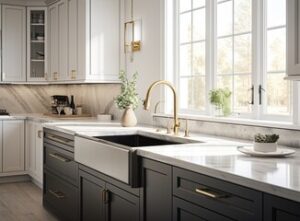A kitchen remodel can be an expensive undertaking. To determine whether a kitchen renovation is the best option, consider your critical goals for the project.

Will you be upgrading worn-out surfaces or improving the flow of your home’s floor plan? A return on investment when you sell may also be an essential consideration. Contact Kitchen Remodeling Atlanta GA for professional help.
The kitchen is the heart of your home and it’s one of the best places to increase resale value. In fact, according to Remodeling magazine’s Cost vs Value report, kitchen remodels recoup more of their costs than many other projects. But how much will your kitchen upgrade cost? The answer will vary, depending on the scope of the remodel and your choice of materials.
For a minor remodeling, new cabinets may cost anywhere from $140 to $360 per linear foot. A new sink can run between $220 and $630. Plumbing costs can rise when major pipe rerouting is required. A new countertop can cost between $500 and $4,000. Installing an island will add to the overall cost.
A major remodel involves replacing or upgrading most of the elements in a kitchen. This can include changing or refinishing countertops, flooring, and lighting as well as installing an island and custom cabinetry. It might also involve adding a dishwasher or refrigerator, upgrading appliances to energy-efficient models, and upgrading the kitchen’s fixtures and faucets. It is often necessary to relocate and disconnect gas, water, and electrical lines to do major work.
For this type of project, it is recommended to hire a design-build professional, who can help keep kitchen costs down by providing recommendations and estimates for trusted contractors and vendors. They can also save money by doing a significant amount of the planning and management work themselves. When choosing a contractor, check their references, BBB rating, online reviews, and insurance coverage. Be sure to ask for samples of previous kitchen remodels. Also, be sure to choose materials and appliances with long-term durability. The kitchen is one of the most used spaces in the house, so it’s important to make sure your upgrade will last for years to come.
Design
The design phase of kitchen remodeling is where homeowners and designers collaborate to envision the ideal layout and aesthetic for the space. This stage includes planning everything from the kitchen floor plan to selecting the right materials for the project. Professional contractors bring this design to life and ensure that all aspects of the kitchen work seamlessly.
Before starting your kitchen remodel, you should take the time to carefully measure the existing room. Having these measurements ready will help your kitchen designer provide a more accurate estimate. You should start by taking the measurements of your walls on a piece of grid paper. Make sure to write down the width, length, and height of each wall in a clear, legible manner. Ideally, you should also note any structural details, such as the location of doors and windows.
Once you have the measurements, you should create an outline of your kitchen on the grid paper. You should also label the walls with their names. It is also a good idea to label any obstructions, such as radiators or structural posts, on the outline. This will save you from having to go back and measure again later on in the process.
You should also mark the locations of any doors and windows in your kitchen on the outline. This will help your designer determine how much cabinet space you have available. You should also take note of any electrical outlets and light fixtures that will need to stay in place. You can use a simple square to mark 90-degree angles, which will help you accurately measure cabinets.
Once you have the base measurements, it is time to begin thinking about how your new kitchen will function. The Work Triangle is a fundamental principle of kitchen design that involves the path you must walk from the refrigerator, sink, and cooktop to prepare food. Ideally, you should try to minimize this distance so that you can easily move around the kitchen. You should also consider how your family will use the kitchen in the future, as this may change your priorities for the space.
Layout
One of the most important aspects of kitchen remodeling is choosing a layout. This will depend on your current space and your desired aesthetic, as well as the way in which you use your kitchen. For example, if you have a large family, you may want to opt for a U-shaped layout with plenty of counter space. Other factors to consider include the number of cooks in your home and how much you enjoy entertaining.
Once you’ve determined your budget and goals, it’s time to start planning your new kitchen layout. Begin by taking measurements of the room and determining how much storage you’ll need. Then, use a kitchen design software like RoomSketcher to create a preliminary floor plan and make changes as necessary. This will help you visualize your ideas and get a better understanding of how they’ll work in the space.
Galley kitchens are a great option for tight spaces because they allow cabinetry and appliances to run along two adjacent walls. They don’t require non-cooks to travel through the kitchen and they can be optimized further with a central island.
L-shaped kitchens are a popular choice because they can be adapted to almost any size of room. They also provide ample counter and storage space for food preparation. This layout is a good choice for most families and can be expanded further with the addition of a kitchen island. Another alternative is a G-shaped kitchen, which is similar to a U-shaped kitchen but wraps around three walls and includes a short bar counter extension at one end. This layout can accommodate more cooks than other kitchen types and is great for larger rooms.
Appliances
Unless you’re planning to recycle your current appliances, kitchen renovations necessitate the purchase of new ones. Your choice of refrigerator, cooking range, microwave oven, dishwasher and hood will affect the style, functionality and value of your home’s kitchen. Choosing these items early in the process is important because your kitchen’s permanent features—custom cabinetry, countertops and backsplash—will be designed around them.
Whether you’re ready to splurge on high-end appliances or want to stay within budget, this is an ideal opportunity to update your home’s look with fresh styles and sleek finishes. Often, these appliances also have features that make them more energy-efficient and user-friendly. For example, smart refrigerators offer features like food-preservation settings and WiFi capability. In addition, many manufacturers and retailers provide kitchen appliance packages with a matching design to add to your home’s aesthetic appeal.
The last thing you want to do is remodel your kitchen and then install a set of cabinets and counters that don’t match. The first big decision you’ll need to make when choosing your kitchen appliances is what size and features are most important to your family. You may have your heart set on a side-by-side fridge and freezer, but that’s not practical if you have a limited floor plan.
For this reason, many homeowners choose to install a separate kitchen island or add an extra sink. These are great ways to expand the work space without sacrificing storage capacity. This is especially important if you entertain guests frequently. Kitchen islands can provide the perfect space for guests to set down their drinks and plates while you’re preparing meals. They also provide a place to store your most commonly used kitchen supplies, such as paper towels and spices.
Lighting
The kitchen is the heart of your home, so it’s important to make sure it’s properly lit. Many homeowners cite a lack of natural light as the reason for their dim kitchens, but lighting fixtures that aren’t the right type or positioned correctly can also contribute to the problem.
When you remodel your kitchen, be sure to include a plan for supplemental lighting in addition to the main overhead lights. The best way to do this is through a layered approach that includes ambient, task and accent lighting. By using a variety of light sources, you can reduce shadows and glare that often result from the exclusive use of overhead lights.
Ambient lighting is soft, overhead light that illuminates the floor and walls so you can easily navigate the space. This type of lighting is the best choice for a kitchen, as it provides enough light to safely move around without being overly bright.
Task lighting is brighter and illuminates specific areas of the kitchen, such as countertops and sinks, for increased precision during food prep or cleaning. This can be achieved with LED light strips under cabinets, recessed lighting above the island or a pendant light over a kitchen table.
Accent lighting is more decorative, and highlights features such as a coffered ceiling or a collection of china. Ideally, accent lighting should be placed over eye-catching features that aren’t essential to the overall function of the kitchen.
Choosing the right lighting for your kitchen is an easy way to add visual interest to the space. You can find a wide array of options available that match your style, from brass metallic pendants to Japanese-inspired wood fixtures. Just be sure to choose the lighting that matches other elements of your kitchen, like your cabinets or countertop material.
